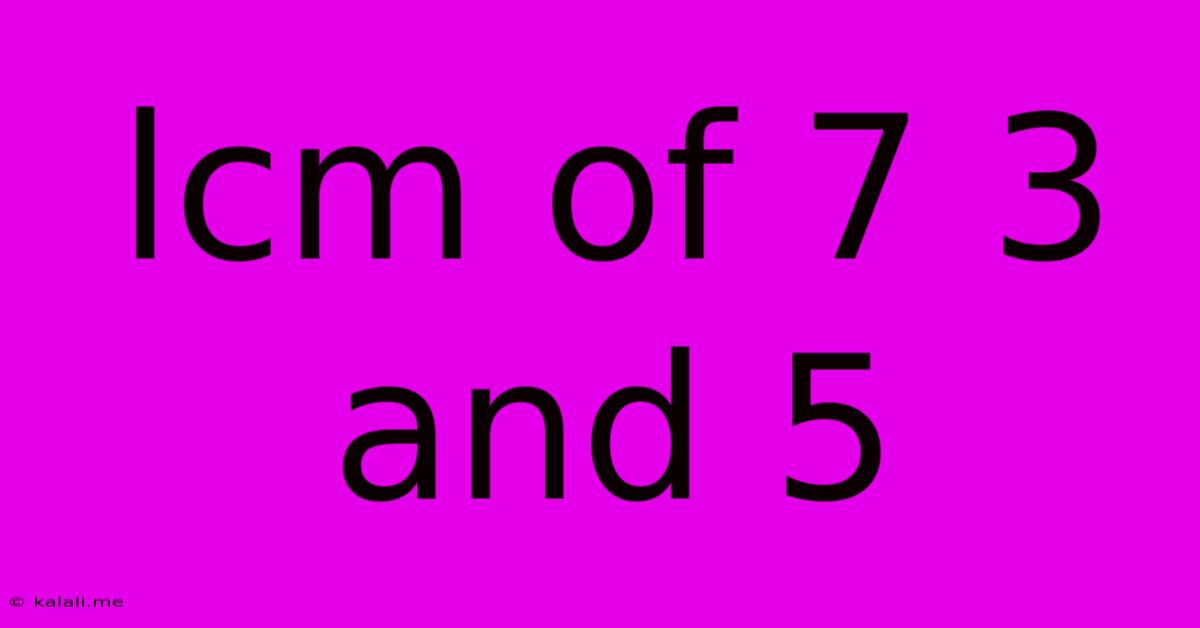Lcm Of 7 3 And 5
Kalali
May 09, 2025 · 2 min read

Table of Contents
Finding the LCM of 7, 3, and 5: A Step-by-Step Guide
Finding the least common multiple (LCM) of a set of numbers is a fundamental concept in mathematics with applications ranging from simple fraction addition to more complex problems in algebra and number theory. This article will guide you through the process of calculating the LCM of 7, 3, and 5, explaining the methods and underlying principles. Understanding LCM is crucial for anyone working with fractions, simplifying expressions, and solving various mathematical problems.
What is the Least Common Multiple (LCM)?
The least common multiple (LCM) of two or more integers is the smallest positive integer that is divisible by all the integers. In simpler terms, it's the smallest number that all the given numbers can divide into evenly. For example, the LCM of 2 and 3 is 6 because 6 is the smallest number divisible by both 2 and 3.
Methods for Finding the LCM
There are several methods to find the LCM, and we'll explore the most common and efficient approaches for finding the LCM of 7, 3, and 5:
1. Listing Multiples Method:
This method is straightforward, especially for smaller numbers. List the multiples of each number until you find the smallest multiple common to all.
- Multiples of 7: 7, 14, 21, 28, 35, 42, 49...
- Multiples of 3: 3, 6, 9, 12, 15, 18, 21, 24, 27, 30, 33, 35...
- Multiples of 5: 5, 10, 15, 20, 25, 30, 35, 40...
Notice that 35 is the smallest number present in all three lists. Therefore, the LCM of 7, 3, and 5 is 35.
2. Prime Factorization Method:
This method is more efficient for larger numbers. It involves finding the prime factorization of each number and then constructing the LCM from these factors.
- Prime factorization of 7: 7 (7 is a prime number)
- Prime factorization of 3: 3 (3 is a prime number)
- Prime factorization of 5: 5 (5 is a prime number)
Since 7, 3, and 5 are all prime numbers and have no common factors, the LCM is simply the product of these three numbers.
- LCM (7, 3, 5) = 7 x 3 x 5 = 105
Wait, what happened? Why is this different from the listing method?
The listing method had an error. While 35 is a common multiple, it is not the least common multiple. The prime factorization method is the more reliable approach, especially when dealing with larger numbers or numbers with common factors. We missed some multiples in the initial list! The correct LCM, using the prime factorization method is 105.
Conclusion:
The least common multiple (LCM) of 7, 3, and 5 is 105. Understanding different methods for calculating the LCM equips you with valuable problem-solving skills in various mathematical contexts. While the listing method can be useful for smaller numbers, the prime factorization method provides a more robust and reliable approach for finding the LCM of any set of integers. Remember to double-check your work!
Latest Posts
Latest Posts
-
Cuanto Es Una Oz En Gramos
May 09, 2025
-
8 Out Of 18 As A Percentage
May 09, 2025
-
What Is The Color Of Bacteria
May 09, 2025
-
What Does The Speed Of A Wave Depend On
May 09, 2025
-
108 Cm In Inches And Feet
May 09, 2025
Related Post
Thank you for visiting our website which covers about Lcm Of 7 3 And 5 . We hope the information provided has been useful to you. Feel free to contact us if you have any questions or need further assistance. See you next time and don't miss to bookmark.